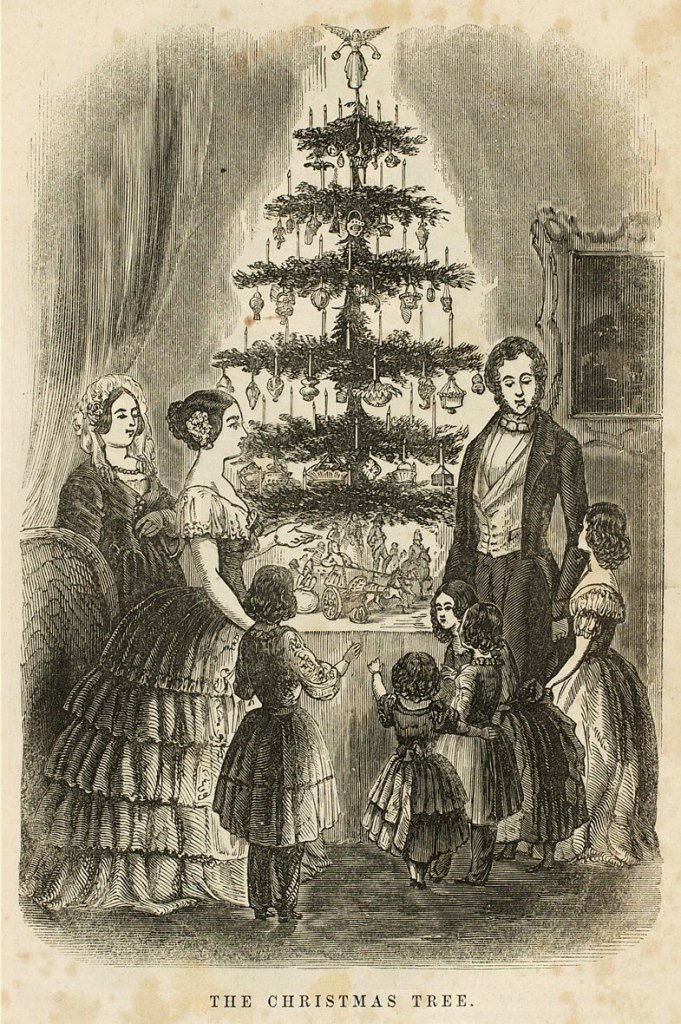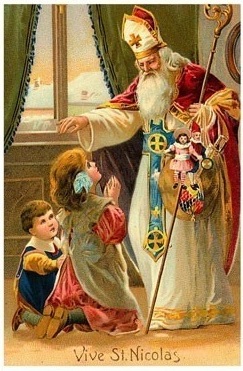Em um post anterior, contamos como surgiu a lenda do Papai Noel (Santa Claus) e se incorporou em nossas tradições natalinas. Nesse aqui, vamos descobrir a história de como o pinheiro se juntou à tradição natalina.

Christmas Tree
The evergreen fir tree has traditionally been used to celebrate winter festivals (pagan and Christian) for thousands of years. Pagans used branches of it to decorate their homes during the winter solstice, as it made them think of the spring to come. The Romans used Fir Trees to decorate their temples at the festival of Saturnalia. Christians use it as a sign of everlasting life with God.
The first documented use of a tree at Christmas and New Year celebrations is argued between the cities of Tallinn in Estonia and Riga in Latvia! Both claim that they had the first trees; Tallinn in 1441 and Riga in 1510. Both trees were put up by the 'Brotherhood of Blackheads' which was an association of local unmarried merchants, ship owners, and foreigners in Livonia (what is now Estonia and Latvia). The facts that Riga's town square is a bit older than Tallinn's, and served as a stopover site for pilgrims, seem to point to the city as the probable site of the first Christmas tree.
There is not very much information available about the first Christmas trees. Sources agree that they were attended by men in black hats and burned at the end of the ceremony; the burning of the Yule log dates back to pagan times in Scandanavia. The log was actually an entire tree that was brought into the house. The largest end was placed in the fireplace, and a fire was started with the remains of the previous year's log. Christians later adopted the practice, and the log was burned during the Twelve Days of Christmas. As this tradition spread throughout Europe, different types of wood became traditionally used in different regions. For example, in England the log was oak, while in Scotland, birch was used.
Because the majority of medieval people were unable to read the Bible, they had to learn its teachings in creative ways. Sacred stories were performed as plays. At first the plays were performed by the clergy in Latin in the church; later it became common for lay people to perform using the vernacular. The plays were very popular, so they were moved to the marketplace to accommodate a large audience, and were called mystery plays because they told the stories of unusual events from the Bible. It is possible that the tradition of the Christmas tree was taken from the use of the Paradise Tree used during mystery plays that were performed on Christmas Eve, which was considered Adam and Eve's Day. The Paradise Tree represented the Garden of Eden. Incidentally, during medieval times there were three types of plays: a mystery play, a miracle play, which was associated with miracles performed by Jesus and the saints, and a morality play, which was to teach moral instruction.
Saint Boniface of England was preaching among the pagan Getmans when he came across the preparations for a human sacrifice. Angry and wishing to stop the sacrifice, he cut down the oak tree. When a fir tree sprang up for its roots, Saint Boniface took it as a sign of the Christian faith. Using candles, he and his followers decorated the tree so that he could preach at night. Another story tells that Boniface was cutting down the Donar Oak or Jupiter's Oak when a wind came and blew the tree down. The pagans were amazed that Jupiter did not strike Boniface down, and immediately converted. Were these stories told to show that Boniface rooted out paganism? He is the patron saint of Germania, and is called the "Apostle of the Germans".
Many sources state that the first Christmas trees brought into the home were decorated with edible treats, such as apples, nuts, and gingerbread. In addition paper roses and candles were used. Eventually glass ornaments were also made. Tinsel, which was hammered from thin pieces of silver, was also invented in Germany. Written in 1605, one German source describes, "At Christmas they set up fir trees in the parlours of Strasbourg and hang thereon roses cut out of many-coloured paper, apples, wafers, gold foil, sweets, etc." The tops of the first Christmas trees were usually decorated with a likeness of the Baby Jesus. Later on, stars, which represented the Star of Bethlehem, and angels, representing the angels telling the shepherds of Christ's birth, were used.
The first person to bring a Christmas Tree into a house, in the way we know it today, may have been the 16th century German preacher Martin Luther. A story is told that, one night before Christmas, he was walking through the forest and looked up to see the stars shining through the tree branches. It was so beautiful, that he went home and told his children that it reminded him of Jesus, who left the stars of heaven to come to earth at Christmas. Some people say this is the same tree as the 'Riga' tree, but it isn't! The Riga tree originally took place a few decades earlier.
Actually the use of evergreen boughs as a special symbol is a long-celebrated tradition.

Questions
1. Where is the first documented evidence of the use of a Christmas tree?
a) London, England
b) Riga, Latvia
c)Warsaw, Poland
d) Berlin, Germany
2. Some people believe that the first Christmas trees were burned after being decorated. This is reminiscent of what Christmas tradition?
a) Advent Wreath
b) Candy Cane
c) The Christmas Pickle
d) Yule Log
3. The first Christmas tree might have been derived from the use of the "Tree of Paradise" in medieval plays. What were these plays called, that frequently taught stories from the Bible?
a) Morality Play
b) Tragic Play
c) Mystery Play
d) Romance
4. There is a legend that an early Christian missionary working among German pagans cut down an oak tree after he found them preparing a human sacrifice there. A new fir tree immediately sprang from the roots of the oak tree. Who was this saint?
a) Saint Jude
b) Saint Nicholas
c) Saint Boniface
d) Saint Christopher
5. Which great religious reformer is given credit for being the first to bring the Christmas tree inside his home?
a) John Calvin
b) Martin Luther
c) John Knox
d) Henry VIII
6. How were the first Christmas trees traditionally decorated once they were brought into the home?
a) Glass Ornaments
b) Gingerbread
c) Silver Tinsel
d) Popcorn Garlands
7. Which type of ornament most likely was placed at the top of the first Christmas trees placed inside the home?
a) Flowers
b) Christ Child
c) Pine Cones
d) Red Bows
08. The use of the evergreen tree to decorate for holiday celebrations existed prior to the introduction of Christianity.
a) True
b) False

Respostas:
1- Riga, Latvia
2 - Yule Log
3 - Mystery Play
4 - Saint Boniface
5 - Martin Luther
6 - ginger bread
7 - Christ Child
8 - False
Gostaram das lendas sobre a tradicional "Árvore de Natal"?
Deixe seu comentário e, aproveitando, compartilhe com seus amigos !
see you soon!








